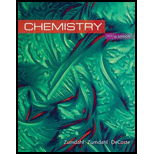
Concept explainers
(a)
Interpretation: The given diagrams are to be labeled as low spin, high spin, or cannot tell with proper explanation.
Concept introduction: Weak field ligand that has small crystal field splitting energy gives high spin due to presence of maximum unpaired electrons in lower energy
Strong field ligand that has large crystal field splitting energy gives low spin due to presence of maximum paired electrons in lower energy
To label: The given diagram as low spin, high spins, or cannot tell with proper explanation.
(b)
Interpretation: The given diagrams are to be labeled as low spin, high spin, or cannot tell with proper explanation.
Concept introduction: Weak field ligand that has small crystal field splitting energy gives high spin due to presence of maximum unpaired electrons in lower energy
Strong field ligand that has large crystal field splitting energy gives low spin due to presence of maximum paired electrons in lower energy
To label: The given diagram as low spin, high spins, or cannot tell with proper explanation.
(c)
Interpretation: The given diagrams are to be labeled as low spin, high spin, or cannot tell with proper explanation.
Concept introduction: Weak field ligand that has small crystal field splitting energy gives high spin due to presence of maximum unpaired electrons in lower energy
Strong field ligand that has large crystal field splitting energy gives low spin due to presence of maximum paired electrons in lower energy
To label: The given diagram as low spin, high spins, or cannot tell with proper explanation.
Trending nowThis is a popular solution!

Chapter 21 Solutions
Chemistry
- Draw the crystal field diagram of [W(CO)6]. Determine the (a) Electronic configuration in terms t2geg (b) Number of unpaired electrons (c) Ligand field stabilization energy in terms of ΔO or ΔTarrow_forward(a) What is the crystal field splitting energy (Δ)?(b) How does it arise for an octahedral field of ligands?(c) How is it different for a tetrahedral field of ligands?arrow_forward4. For each of the following transition metal complex ions : see image (i) Draw the structure of the transition metal complex ion. Show the charge on the complex in your structure.(ii) Give the oxidation state of the metal.(iii) State whether the complex is high spin or low spin or not applicable. Providereasons for your answer.(iv) Draw the arrangement of d-electrons in the ground state. Label the orbital sets.(v) Calculate the LFSE (in units of ∆o or ∆T) for each complexarrow_forward
- Predict the products of each of the following reactions and then balance the chemical equations.(a) Fe is heated in an atmosphere of steam.(b) NaOH is added to a solution of Fe(NO3)3.(c) FeSO4 is added to an acidic solution of KMnO4.(d) Fe is added to a dilute solution of H2SO4.(e) A solution of Fe(NO3)2 and HNO3 is allowed to stand in air.(f) FeCO3 is added to a solution of HClO4.(g) Fe is heated in air.arrow_forwardIdentify each of the following coordination complexes as either diamagnetic or paramagnetic: (a) [CoBr(NH3)5]²+ (b) [W(CN)6]³- (c) [VF6]³- (d) [Rh(o-phen);]*+arrow_forwardConsider the following compound that obeys the 18-electron rule. Predict the first-row transition metal present in it. CO OC 〇〇 (A) Co (B) Fe (C) Mn (D) Crarrow_forward
- 6 By sketching a crystal field diagram for [Co(sep)]DTC3, predict whether you think the compound will have a magnetic moment or notarrow_forward3. A solution of [Ni(NH3)6]Cl2 is blue and paramagnetic. (Atomic number of Ni = 28) (a) Write the valence electron configuration of the central metal atom/ion. (b) Predict the hybridization of the above complex and show the hybridized orbital diagram. (c) Suggest the geometry of the above complex.arrow_forward5. (a) (b) The complex ion NiC14² has two unpaired electrons, whereas Ni(CN)4² is diamagnetic. Propose structures for these two complex ions (square-planar or tetrahedral). Draw the crystal field diagrams of two complex ions.arrow_forward
 Chemistry: An Atoms First ApproachChemistryISBN:9781305079243Author:Steven S. Zumdahl, Susan A. ZumdahlPublisher:Cengage Learning
Chemistry: An Atoms First ApproachChemistryISBN:9781305079243Author:Steven S. Zumdahl, Susan A. ZumdahlPublisher:Cengage Learning
 ChemistryChemistryISBN:9781305957404Author:Steven S. Zumdahl, Susan A. Zumdahl, Donald J. DeCostePublisher:Cengage Learning
ChemistryChemistryISBN:9781305957404Author:Steven S. Zumdahl, Susan A. Zumdahl, Donald J. DeCostePublisher:Cengage Learning Principles of Modern ChemistryChemistryISBN:9781305079113Author:David W. Oxtoby, H. Pat Gillis, Laurie J. ButlerPublisher:Cengage Learning
Principles of Modern ChemistryChemistryISBN:9781305079113Author:David W. Oxtoby, H. Pat Gillis, Laurie J. ButlerPublisher:Cengage Learning General Chemistry - Standalone book (MindTap Cour...ChemistryISBN:9781305580343Author:Steven D. Gammon, Ebbing, Darrell Ebbing, Steven D., Darrell; Gammon, Darrell Ebbing; Steven D. Gammon, Darrell D.; Gammon, Ebbing; Steven D. Gammon; DarrellPublisher:Cengage Learning
General Chemistry - Standalone book (MindTap Cour...ChemistryISBN:9781305580343Author:Steven D. Gammon, Ebbing, Darrell Ebbing, Steven D., Darrell; Gammon, Darrell Ebbing; Steven D. Gammon, Darrell D.; Gammon, Ebbing; Steven D. Gammon; DarrellPublisher:Cengage Learning Chemistry: Principles and PracticeChemistryISBN:9780534420123Author:Daniel L. Reger, Scott R. Goode, David W. Ball, Edward MercerPublisher:Cengage Learning
Chemistry: Principles and PracticeChemistryISBN:9780534420123Author:Daniel L. Reger, Scott R. Goode, David W. Ball, Edward MercerPublisher:Cengage Learning





